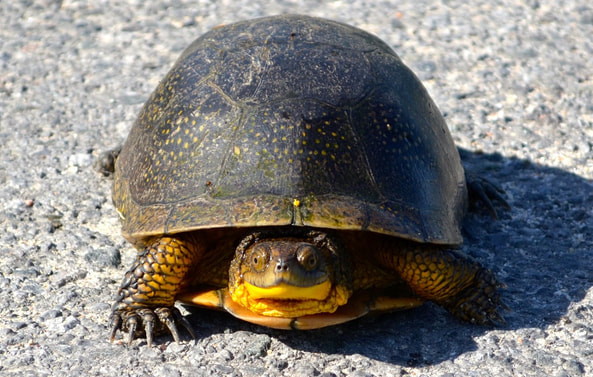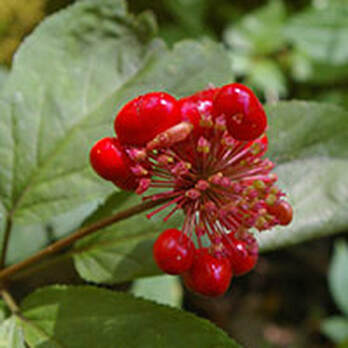Species at Risk
Introduction to Species at Risk (SAR)
By definition, species at risk are those which are in danger of becoming extinct of extirpated. Species at risk are typically at risk due to environmental or human-induced changes to them or their habitat(s) on a local, regional, or global scale. Species at risk are not to be confused with Rare Species, which include those than naturally appear in low numbers or solely in highly restricted areas. It is important to note that not all rare species are at risk.
Species can be considered at risk locally or on a global scale and they can also be ranked at different levels of risk for extinction. To assess this, species are listed by different agencies for different parts of the world. Blanding's turtles (seen here) are a species at risk in Canada. This turtle is one of three Blanding's turtles that have been found at Plenty Canada.
By definition, species at risk are those which are in danger of becoming extinct of extirpated. Species at risk are typically at risk due to environmental or human-induced changes to them or their habitat(s) on a local, regional, or global scale. Species at risk are not to be confused with Rare Species, which include those than naturally appear in low numbers or solely in highly restricted areas. It is important to note that not all rare species are at risk.
Species can be considered at risk locally or on a global scale and they can also be ranked at different levels of risk for extinction. To assess this, species are listed by different agencies for different parts of the world. Blanding's turtles (seen here) are a species at risk in Canada. This turtle is one of three Blanding's turtles that have been found at Plenty Canada.
Causes Resulting in Species Becoming at Risk
There are many natural and non-natural cause which can result in a species being put at risk that can be broadly categorizes into habitat disturbance or destruction, invasive (non-native) species, and global (climate) changes.
Species at risk due to habitat disturbance or destruction typically occurs due to human activity. The survival of a species depends on the survival of its habitat. If the area in which it lives, feeds, or breeds is disturbed or destroyed, then the species only has three options; it is either to adapt to the changes, relocate, or die, causing populations to dwindle and putting the species at risk.
The invasion of species that are not native to a specific area can become introduced either accidentally (by humans, or on their own accord), or for experimental purposes. The newly introduced species can become a threat to existing species if they outcompete for food, habitat, or if they prey on the native species.
Climate changes such as global warming and global pollution can cause many species to fall at risk. Most known species have limited tolerance for environmental changes and if this tolerance is exceeded, then it is likely that the species population in the affected area(s) will suffer.
Protecting Species at Risk
In 1987 Canada established the Endangered Spaces Campaign. This was a 10-year campaign that ended in 2000 by adding a total of 38 million hectares to Canada’s parks and protected areas. There is also the Species at Risk Act implemented by the Government of Canada. This is an Act to protect wildlife species at risk in Canada that recognizes Canada’s national heritage is an integral part of our national identity.
Species at Risk Act (Canada)
The Species at Risk Act was introduced in Canada in 2002 with the purpose of preventing wildlife species from being extirpated or becoming extinct, to provide for the recovery of wildlife species that are extirpated, endangered, or threatened as a result of human activity and to manage species of special concern to prevent them from becoming endangered or threatened. The Act also consists of a Stewardship Action Plan that can create incentives and other measures to support voluntary stewardship actions by any government within Canada.
The Act can be found here: http://laws-lois.justice.gc.ca/PDF/S-15.3.pdf
There are many natural and non-natural cause which can result in a species being put at risk that can be broadly categorizes into habitat disturbance or destruction, invasive (non-native) species, and global (climate) changes.
Species at risk due to habitat disturbance or destruction typically occurs due to human activity. The survival of a species depends on the survival of its habitat. If the area in which it lives, feeds, or breeds is disturbed or destroyed, then the species only has three options; it is either to adapt to the changes, relocate, or die, causing populations to dwindle and putting the species at risk.
The invasion of species that are not native to a specific area can become introduced either accidentally (by humans, or on their own accord), or for experimental purposes. The newly introduced species can become a threat to existing species if they outcompete for food, habitat, or if they prey on the native species.
Climate changes such as global warming and global pollution can cause many species to fall at risk. Most known species have limited tolerance for environmental changes and if this tolerance is exceeded, then it is likely that the species population in the affected area(s) will suffer.
Protecting Species at Risk
In 1987 Canada established the Endangered Spaces Campaign. This was a 10-year campaign that ended in 2000 by adding a total of 38 million hectares to Canada’s parks and protected areas. There is also the Species at Risk Act implemented by the Government of Canada. This is an Act to protect wildlife species at risk in Canada that recognizes Canada’s national heritage is an integral part of our national identity.
Species at Risk Act (Canada)
The Species at Risk Act was introduced in Canada in 2002 with the purpose of preventing wildlife species from being extirpated or becoming extinct, to provide for the recovery of wildlife species that are extirpated, endangered, or threatened as a result of human activity and to manage species of special concern to prevent them from becoming endangered or threatened. The Act also consists of a Stewardship Action Plan that can create incentives and other measures to support voluntary stewardship actions by any government within Canada.
The Act can be found here: http://laws-lois.justice.gc.ca/PDF/S-15.3.pdf
Importance to Indigneous Peoples
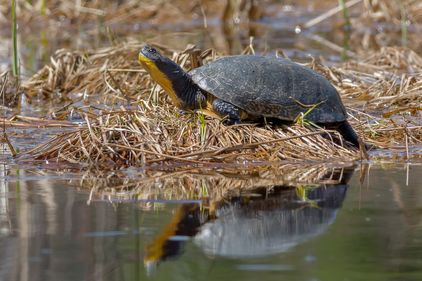 Photo: PaulReevesPhotography Getty Images
Photo: PaulReevesPhotography Getty Images
Indigenous peoples in Canada have suffered the results of the decline of traditional culturally significant species. Most Indigenous Peoples have relied on relationships with wildlife through natural law for survival, by observing and monitoring wildlife for guidance on how to engage with creation - what to eat, what will make you sick, good places to hide, materials for building, etc. This intimate knowledge makes Indigenous Peoples integral in wildlife management and conservation. A few important examples of culturally significant species that are at risk in this region include:
Mikinàk, A'nó:wara, Turtle, (order Testudines)
There are eight native turtle species found in Ontario, seven of which are considered to be species at risk, including the wood turtle, blanding’s turtle, eastern musk turtle, northern map turtle, snapping turtle, spiny softshell turtle, and spotted turtle. Although painted turtles are not listed as “at risk”, the western midland painted turtle subspecies has been designated as Special Concern by the Committee on the Status of Endangered Wildlife in Canada (COSEWIC), and the entire species is not nearly as abundant as it was at the time of first contact with Europeans.
The southern portion of Ontario contains significant freshwater habitats such as hundreds of streams, rivers, lakes, and wetlands, including significant coastal wetlands along the Great Lakes. Habitat fragmentation, loss of connectivity, and urbanization around these habitats threatens the survival of the turtles that live in and depend on them. In the past century, over 75% of wetlands in southern Ontario have been drained, destroyed, or filled in for agricultural and urban development. Because turtles generally do not have great economic value, and because of their elusive nature, they are not always viewed as a high priority for protection. However, turtles play an integral part in the relationships between all beings in wetland and aquatic environments, acting as both predator and prey.
The shell of a turtle is composed of bony plates, and is usually covered with horn-like scales called scutes, forming the upper (carapace) and lower (plastron) portions. The carapace usually has a pattern of 13 large scutes encircled by 28 smaller scutes. The backbone and ribs of the turtle are fused to the underside of the carapace, meaning that turtles cannot remove their shells, and damage to it can be very serious. Many Anishnaabe and Haudenosaunee Peoples use the turtle’s back as a calendar, representing the 13 lunar months with 28 days each. The changes that come with each passing moon indicate the times for planting, harvesting, hunting and gathering. In these calendars, the names of each month include the word ‘moon’ and reflect the close connection between the cycles of the moon and the plant and animal life on Turtle Island. These moons are referred to as the grandmother teachings or grandmother moons.
The turtle is also an important part of creation in Anishnaabe and Haudenosaunee creation stories. The World starts with the arrival of Sky Woman who fell from the Sky World. While the geese helped to slow her fall, they could not hold her. The animals of the world would have despaired if the Great Turtle had not agreed to bear Skywoman on her back. This is why North America is known as Turtle Island.
Turtles, to all Indigenous people of this land, are the very foundation of the spiritual, physical and political world and each of them have their own stories.
Mikinàk, A'nó:wara, Turtle, (order Testudines)
There are eight native turtle species found in Ontario, seven of which are considered to be species at risk, including the wood turtle, blanding’s turtle, eastern musk turtle, northern map turtle, snapping turtle, spiny softshell turtle, and spotted turtle. Although painted turtles are not listed as “at risk”, the western midland painted turtle subspecies has been designated as Special Concern by the Committee on the Status of Endangered Wildlife in Canada (COSEWIC), and the entire species is not nearly as abundant as it was at the time of first contact with Europeans.
The southern portion of Ontario contains significant freshwater habitats such as hundreds of streams, rivers, lakes, and wetlands, including significant coastal wetlands along the Great Lakes. Habitat fragmentation, loss of connectivity, and urbanization around these habitats threatens the survival of the turtles that live in and depend on them. In the past century, over 75% of wetlands in southern Ontario have been drained, destroyed, or filled in for agricultural and urban development. Because turtles generally do not have great economic value, and because of their elusive nature, they are not always viewed as a high priority for protection. However, turtles play an integral part in the relationships between all beings in wetland and aquatic environments, acting as both predator and prey.
The shell of a turtle is composed of bony plates, and is usually covered with horn-like scales called scutes, forming the upper (carapace) and lower (plastron) portions. The carapace usually has a pattern of 13 large scutes encircled by 28 smaller scutes. The backbone and ribs of the turtle are fused to the underside of the carapace, meaning that turtles cannot remove their shells, and damage to it can be very serious. Many Anishnaabe and Haudenosaunee Peoples use the turtle’s back as a calendar, representing the 13 lunar months with 28 days each. The changes that come with each passing moon indicate the times for planting, harvesting, hunting and gathering. In these calendars, the names of each month include the word ‘moon’ and reflect the close connection between the cycles of the moon and the plant and animal life on Turtle Island. These moons are referred to as the grandmother teachings or grandmother moons.
The turtle is also an important part of creation in Anishnaabe and Haudenosaunee creation stories. The World starts with the arrival of Sky Woman who fell from the Sky World. While the geese helped to slow her fall, they could not hold her. The animals of the world would have despaired if the Great Turtle had not agreed to bear Skywoman on her back. This is why North America is known as Turtle Island.
Turtles, to all Indigenous people of this land, are the very foundation of the spiritual, physical and political world and each of them have their own stories.
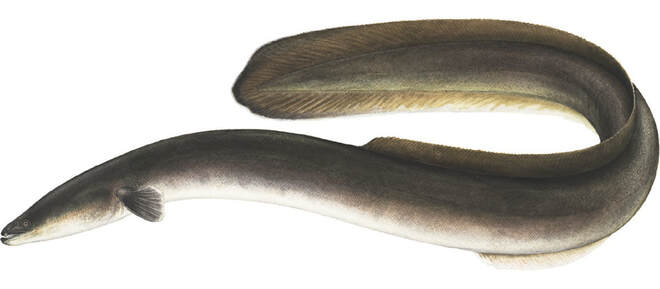 Photo: Ellen Edmonson and Hugh Chrisp, public domain
Photo: Ellen Edmonson and Hugh Chrisp, public domain
Pimizì, Ohstonhnéha Kiawerón:ko, American Eel, Anguilla rostrata
The American eel is a catadromous (migrates from freshwater to the sea to spawn) fish, and is the only freshwater eel in North America. It has a long, slender body with small scales that are covered with a mucus layer, a single fin extends from its back around the tail to its belly, a protruding lower jaw, several rows of small teeth on the jaws and roof of the mouth, and a small gill opening in front of the pectoral fins, which are located high up on the side of the body.
All American eels are part of a single breeding population that spawns in only one place in the world- the Sargasso Sea in the Atlantic Ocean. After spawning, eggs hatch within roughly one week. The larvae drift with the ocean current to the western shores of the Atlantic Ocean. When larvae reach 55-65 mm in length, they metamorphose into ‘glass eels’, a post-larval stage characterized by a lack of pigment. As they approach coastal estuaries, they become pigmented and are known as ‘elvers’. This stage lasts 3-12 months, during which they may migrate up rivers or remain in brackish or salt waters, growing into juveniles or ‘yellow eels’ which are yellowish green or olive-brown on the belly and dark on the back. It then takes from 8 to 23 years of growth for ‘yellow eels’ to become adult ‘silver eels’, which are grey with a white or cream-colored belly. The females may reach up to 1 m in length and males are smaller at less than 0.4 m. At this stage they are able to migrate back to their spawning grounds in the sea where they die after spawning. The larvae are believed to feed primarily on detritus (particulate organic material), while glass eels and elvers consume insect larvae. Yellow eels are night feeders and prey on a variety of organisms including small fishes, molluscs, insects and crustaceans. Silver eels do not feed during the spawning migration.
The St. Lawrence River and its tributaries provided a rich environment for American eels; populations numbering in the billions were not unusual during the pre-contact times. The sheer number of migrating eels in the St. Lawrence River would cause the surface water to shimmer and people would gather to watch the eels return. However, the number of eels began to decline sharply from about 1970 on, and it has now practically disappeared from Algonquin territory.
The biggest threats to American eel in this region are hydro-electric turbines that kill eels that try to pass through the turbines during their downstream spawning migration, as well as dams and other in-water barriers that prevent access to feeding areas and migration routes. Invasive species and chemical contaminants may also pose a threat. Fishing has also had an impact, although fishing is no longer allowed in Ontario. Climate change may also pose a threat as changes to the Gulf Stream patterns could interfere with migration.
The American eel has long been a sacred food, medicine and responsibility of the Indigenous Peoples in Eastern Ontario. It was once a mainstay of the diets of Indigenous communities in this region, sustaining them especially during the hard winter months. The fat content is six times greater than any other freshwater fish, so they were used when travelling because small amounts provide a high-energy meal. In times of famine, smoked eel skin was the food that offered final hope of surviving starvation.
Although it was extremely important as food, Indigenous people also traditionally had many non-food uses for the species, and because the eel was sacred, all of it was used. The skin is thick and durable and has the property of tightening, making it useful for many purposes including binding sleds, moccasins, clothing, hair strings, tying spears and harpoons on sticks, making lacrosse balls, covering bow grips, splints for broken bones, support garters to relieve sprains, and being worn next to the skin for relief from cramps and rheumatism. Fresh eel flesh was applied to clothing to waterproof it, especially on footwear and outer clothing. The fat was used on the skin and hair to protect from sun, wind and insects. The heart, liver and heads were used as bait, or buried as offerings after successful hunting or fishing.
“I believe that Eel spirit is intrinsic to the Sacred Seven Fire Prophecy Wampum Belt. This unique and mysterious ancient creature was of tremendous significance to the original Peoples of the eastern coast of North America, and in the stories of my ancestors, it was plentiful beyond imagination; the Eel was of great spiritual, nutritional and material importance to the people from time immemorial. Intimately connected with peoples of the land, the Eel played a pivotal role in the Donald Marshall Junior landmark legal victory in the recognition of Indigenous rights.” -Ojigkwanong (Elder William Commanda), Kitigàn-zìbì Anishinàbeg First Nation
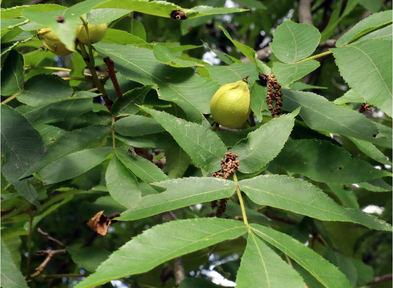 Photo: Dcwcreations Getty Images
Photo: Dcwcreations Getty Images
Pagànàkominaganj , Akiehwà:ta, Butternut, Juglans cinerea
Butternut (also known as white walnut) is a medium-sized tree that can reach up to 30 m in height. It belongs to the walnut family and produces edible nuts in the fall. The bark of younger trees is grey and smooth, becoming ridged as it ages. It is easily recognized by its compound leaves, which are made up of 11-17 leaflets arranged in a feather-like pattern. The fruit is a large nut that contains a single seed surrounded by a light green, sticky, fuzzy husk. In Ontario, butternut usually grows alone or in small groups in deciduous forests.
Butternut Canker is a fungal disease that spreads quickly and can kill a tree within a few years. This fungus has already had a devastating impact on North American butternut populations. Surveys in eastern Ontario show that most trees are infected, and perhaps one-third have already been killed. Some infected butternut trees live for many years. Experts hope this is an indication of resistance to the disease.
The tree can be tapped for sap, much in the same manner as maple syrup, and Algonquin and other Indigenous Peoples have used the sap and bark to treat toothaches, injuries and digestive problems. The fresh nuts can be crushed and boiled and served as either baby food or a drink. The crushed nuts can be used for breads, puddings, and sauces as well as mixed into dishes such as mashed potatoes. The oils can also be used to condition hair and can be mixed with bear grease to ward off mosquitos. Another well-known usage is the yellow-brown dye that can be extracted from the inner bark by boiling it.
Butternut (also known as white walnut) is a medium-sized tree that can reach up to 30 m in height. It belongs to the walnut family and produces edible nuts in the fall. The bark of younger trees is grey and smooth, becoming ridged as it ages. It is easily recognized by its compound leaves, which are made up of 11-17 leaflets arranged in a feather-like pattern. The fruit is a large nut that contains a single seed surrounded by a light green, sticky, fuzzy husk. In Ontario, butternut usually grows alone or in small groups in deciduous forests.
Butternut Canker is a fungal disease that spreads quickly and can kill a tree within a few years. This fungus has already had a devastating impact on North American butternut populations. Surveys in eastern Ontario show that most trees are infected, and perhaps one-third have already been killed. Some infected butternut trees live for many years. Experts hope this is an indication of resistance to the disease.
The tree can be tapped for sap, much in the same manner as maple syrup, and Algonquin and other Indigenous Peoples have used the sap and bark to treat toothaches, injuries and digestive problems. The fresh nuts can be crushed and boiled and served as either baby food or a drink. The crushed nuts can be used for breads, puddings, and sauces as well as mixed into dishes such as mashed potatoes. The oils can also be used to condition hair and can be mixed with bear grease to ward off mosquitos. Another well-known usage is the yellow-brown dye that can be extracted from the inner bark by boiling it.
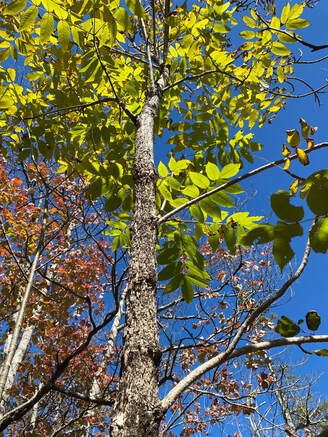 Photo: tomneily iNaturalist
Photo: tomneily iNaturalist
Bwoyaak, Éhsa, Black Ash, Fraxinus nigra
Black ash is a medium-sized, shade-intolerant hardwood tree species that occurs on moist to wet sites such as swamps, bogs, fens, floodplains, and riparian areas. It is a broad-leaved hardwood tree in the Olive family, growing 15 to 20 m in height, but can grow to as high as 27 m, and 30 to 50 cm in diameter. The leaves are pinnately-compound with 7-11 leaflets. Black ash is a dominant species in many swamp forest and riparian ecosystems, in which it provides food and shelter for many species, including at least ten Canadian ash-specialist arthropods.
Black ash is highly susceptible to the invasive Emerald Ash Borer, an invasive beetle, and subpopulations in the central part of the distribution have been devastated. This invasive species was first detected in Canada (Windsor, Ontario) in 2002 and has since expanded its range in Canada from the prairies to the maritimes. Conversion of forest to other land uses since European settlement has produced significant declines in the Great Lakes Plains. Climate change is predicted to significantly reduce the region suitable for black ash.
Black ash helps to repair damaged cells from insulin resistance, reproductive stresses, and other bodily stresses by promoting more efficient energy mobilisation in the body between the liver, muscles and fat. Infusions of the inner bark have been used as a tonic for the liver and stomach, to treat painful urination, and as an eye wash for sore eyes. As a woman’s medicine, black ash can help with calming cramps and muscle spasms by promoting more effective shedding of the uterine lining during menstruation. The leaves have been used as a diaphoretic, diuretic, and laxative. Black ash wood is strong but highly flexible and readily separates into thin strips, making it extremely useful in applications requiring bending. It can be used to make snowshoe frames, canoe ribs, ash baskets, fish traps, barrel hoops, and chair seats.
“Ash being a hardwood, it is very lightweight but very durable, strong – which is probably why we came up with the idea to use them. Also, for basket making, for fish traps, the layers separate really easily once you start pounding them. And so, like I said, we haven’t found a replacement.” -Chuck Commanda, master birch-bark canoe builder, Kitigàn-zìbì Anishinàbeg First Nation
Black ash is a medium-sized, shade-intolerant hardwood tree species that occurs on moist to wet sites such as swamps, bogs, fens, floodplains, and riparian areas. It is a broad-leaved hardwood tree in the Olive family, growing 15 to 20 m in height, but can grow to as high as 27 m, and 30 to 50 cm in diameter. The leaves are pinnately-compound with 7-11 leaflets. Black ash is a dominant species in many swamp forest and riparian ecosystems, in which it provides food and shelter for many species, including at least ten Canadian ash-specialist arthropods.
Black ash is highly susceptible to the invasive Emerald Ash Borer, an invasive beetle, and subpopulations in the central part of the distribution have been devastated. This invasive species was first detected in Canada (Windsor, Ontario) in 2002 and has since expanded its range in Canada from the prairies to the maritimes. Conversion of forest to other land uses since European settlement has produced significant declines in the Great Lakes Plains. Climate change is predicted to significantly reduce the region suitable for black ash.
Black ash helps to repair damaged cells from insulin resistance, reproductive stresses, and other bodily stresses by promoting more efficient energy mobilisation in the body between the liver, muscles and fat. Infusions of the inner bark have been used as a tonic for the liver and stomach, to treat painful urination, and as an eye wash for sore eyes. As a woman’s medicine, black ash can help with calming cramps and muscle spasms by promoting more effective shedding of the uterine lining during menstruation. The leaves have been used as a diaphoretic, diuretic, and laxative. Black ash wood is strong but highly flexible and readily separates into thin strips, making it extremely useful in applications requiring bending. It can be used to make snowshoe frames, canoe ribs, ash baskets, fish traps, barrel hoops, and chair seats.
“Ash being a hardwood, it is very lightweight but very durable, strong – which is probably why we came up with the idea to use them. Also, for basket making, for fish traps, the layers separate really easily once you start pounding them. And so, like I said, we haven’t found a replacement.” -Chuck Commanda, master birch-bark canoe builder, Kitigàn-zìbì Anishinàbeg First Nation

